
from the plethora of parked cars that this garden is attracting many visitors.
.
If you have any comments, observations, or questions about what you read here, remember you can always Contact Me
All content included on this site such as text, graphics and images is protected by U.S and international copyright law.
The compilation of all content on this site is the exclusive property of the site copyright holder.
Designed For Nature: Marcello and Priya Mangano Garden
Saturday, 18 June 2022
There is a garden tour today, presenting five local residential gardens in transition to the use of native plants and creative water management. Organized and presented by The Woman's National Farm & Garden Association, Bucks County Branch, in partnership with Bowman's Hill Wildflower Preserve. Rain or shine, 10:00 a.m. to 3:00 p.m. Be inspired, we are told, to see what can be done to bring nature back into your own private oasis. Generously provided with a gratis media pass, I decide I will see as many gardens as my knee allows. Weather is cooperative, with comfortable temperatures and some overcast that filters the sunlight and makes for better pictures. And I'm off!
Garden of Marcello and Priya Mangano
Located on the cul-de-sac at the end of a dead end street it is obvious

from the plethora of parked cars that this garden is attracting many visitors.

There is a new garden, right in front, that was planted only last year.
The plants were small, started just from plugs rather than larger pots.

The liatris will be spectacular in bloom, attracting masses of butterflies.
In autumn, when they've gone to seed, the goldfinches will arrive to feed.
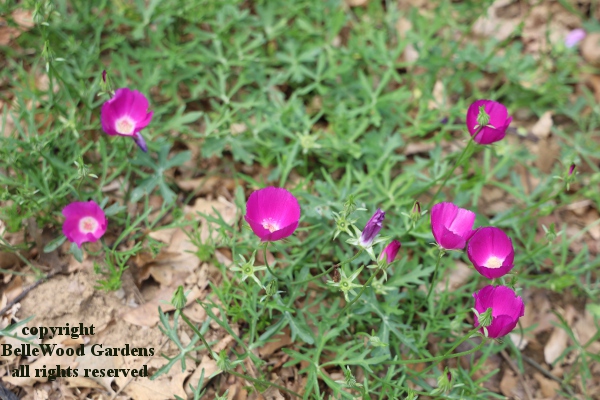
The vivid fuchsia flowers at the base of the liatris are Callirhoe, wine cups.
There are other native plants, to add interest earlier and later.

These bold silphium will grow even more stately, and
crown themselves with bright yellow daisy like flowers.
 .
. .
.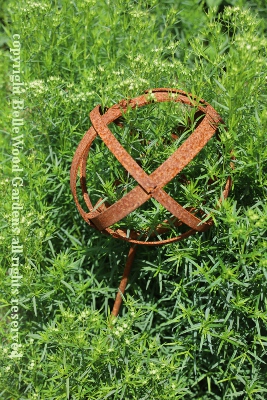
Some fanciful objets d'art are tucked in amongst the native plants. It is, after all, a garden.
"Many of the materials used to create the beds were sourced locally, mostly with donations of 'waste' material destined for the landfill such as wood chips, . . . bluestone for the pathways . . ."
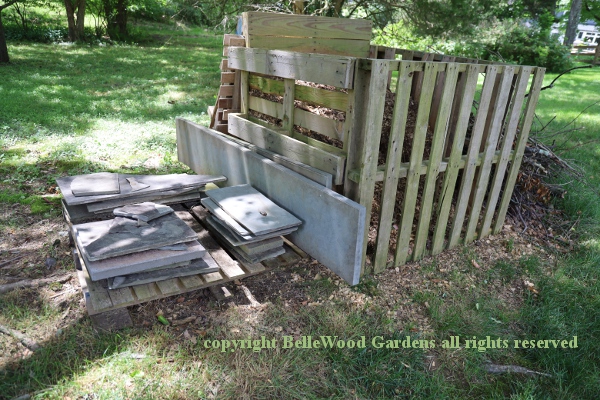
Tucked discretely on the side of the property, paving stones and a bin of mulch.
The material is conveniently at hand for use with one of the shady beds
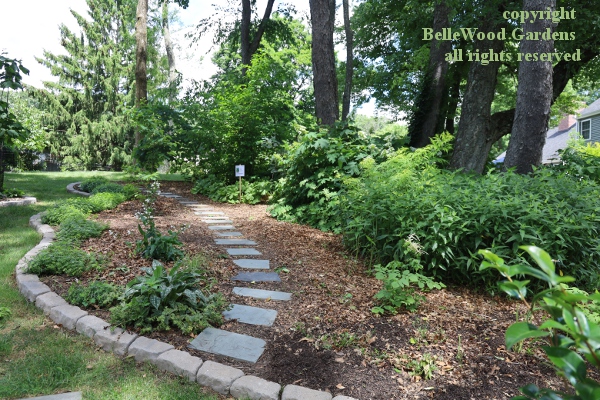
under the trees. Notice that there is a raised lip or edge to the bed, as for most.
The soil, I was told, is very stony. Free draining but a pickaxe is needed to make a planting hole of any size and depth. After doing this for the first two hemlocks then said, "Enough!" And since then lasagna planting is the preferred technique. Layer natural debris and leaves, including extra leaves "rescued" from the neighbors curbs. Wood ashes to moderate the soil's natural acidity. Extra nutrients are also provided on site.
As an aside - I recently read two article about toilets with diverters for liquid waste, to be collected and used as fertilizer. Urine is sterile as voided, and so high in nitrogen that it should be diluted 10:1 for use on mature plants, 20:1 for seedlings. Back to the garden.
I noticed a shabby looking area at the rear of the property, fenced off with a decorative fence.
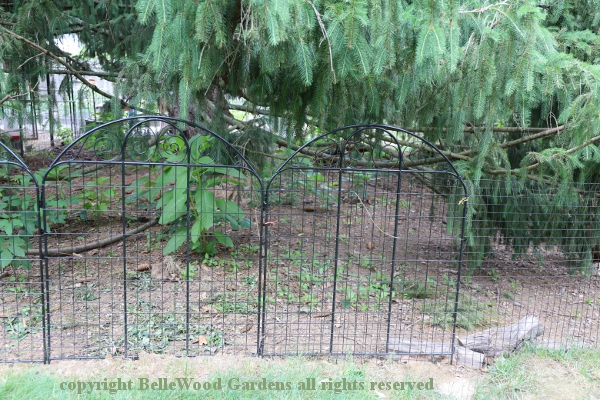
A couple of evergreens, spruce, I think, and mostly bare, somewhat compacted soil. Aha!
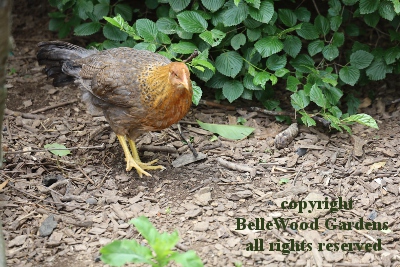 .
.
It is a dual purpose food and fertilizer setup, with assorted chickens laying eggs of many colors.
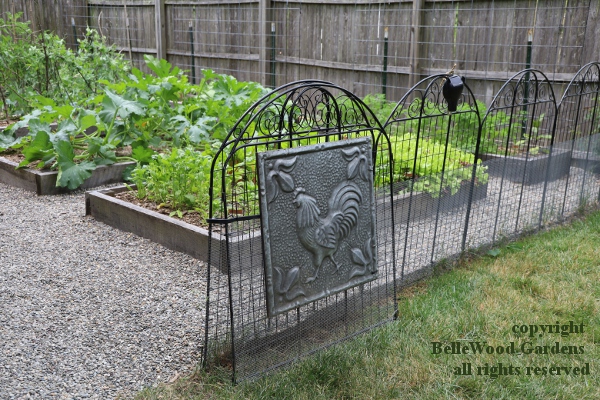
There is a productive vegetable garden too, with appropriate gate and a "chicken crossing" sign.
Designing for nature offers multiple possibilities. It does mean using native plants.

It does not require the duplication of native plant communities.
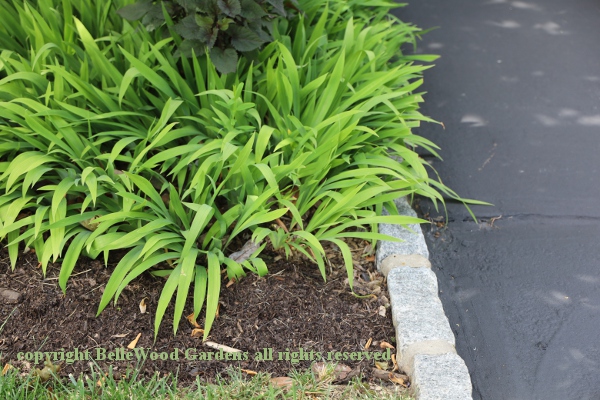
Take, for example, our native Iris cristata, a wonderful plant for sun / shade boundaries
with attractive swordlike foliage and attractive, dainty, blue or white iris flowers in spring.

Here's a conundrum for you to consider. Should a cultivar of a native plant
still be considered native? Case in point, this variegated solomon's seal,
a wonderful plant to brighten a shady corner with its white edged leaves.

The bananas emerging from the variegated solomon's seal are survivors.
Musa basjoo, the Japanese fiber banana is quite hardy. It was last year
that it was planted so these survived the cold. Alas, their fruits are inedible.

There is a native sedum, but this is not it. A neighbor was
digging out and discarding some that had been growing
for 20 years. Reluctant to see it composted, it was given
a home in this urn. Where it looks quite attractive, agreed?

Not Cousin Itt, not a haystack. Look at the leaves.
This is a magnificent weeping Cercis canadensis.

There is this pen adjacent to the terrace behind the house. Not especially rare plants,
or some that need to be confined for some reason. Before I could ask someone else
inquired. And we were told that this is where
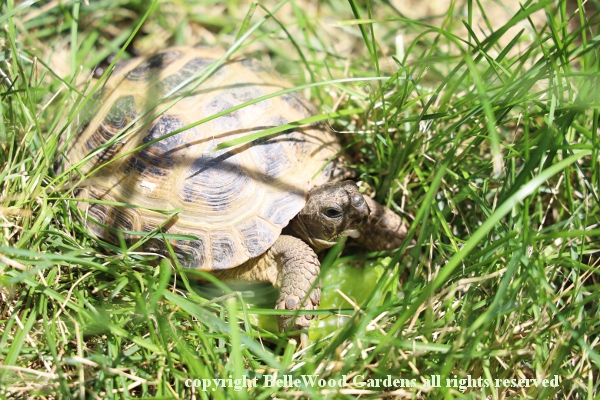
a tortoise has a happy home! The pen is now covered with hog panels because
a fox grabbed him out of the pen, biting and scratching up his carapace before
he was rescued. There's a tunnel down into the ground for winter hibernation.
This property fits right in with others in the neighborhood of tree shaded properties and sweeping lawns. If you know they are natives there is an extra frisson of awareness. If not, these are simply other beautiful plants anyone would be delighted to have in their garden.
The other gardens I visited are those of garden of Ann Boyer and Steve Auslander and the the garden of Beverley Rhinesmith and Paul Patent
Back to Top
Back to June
Back to the main Diary Page